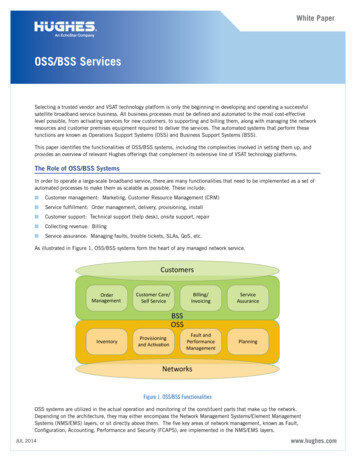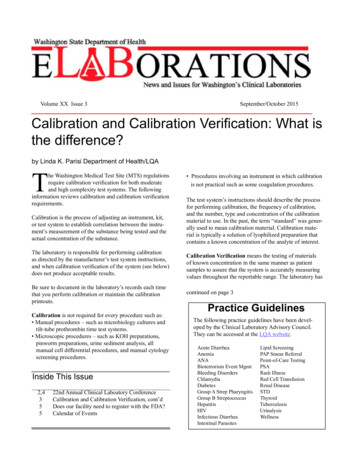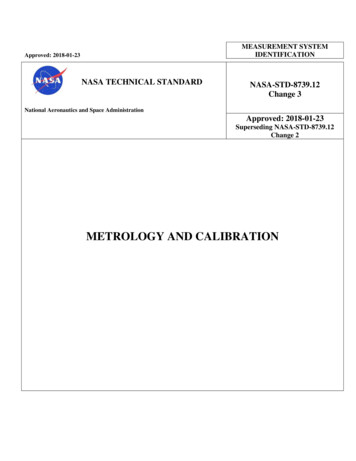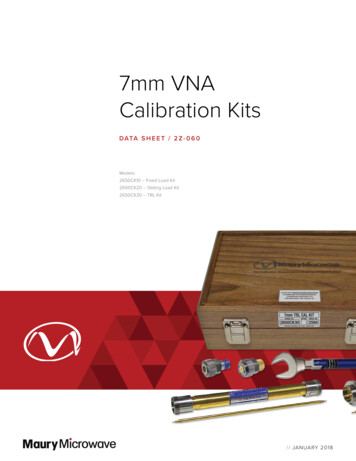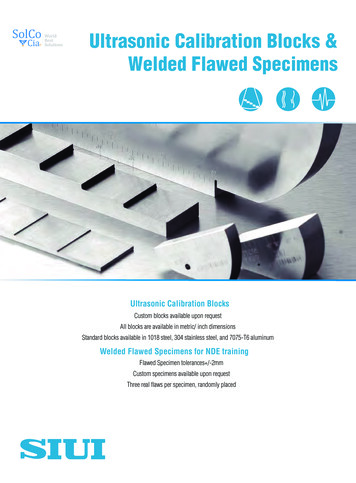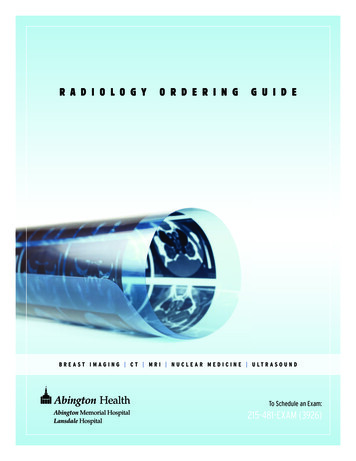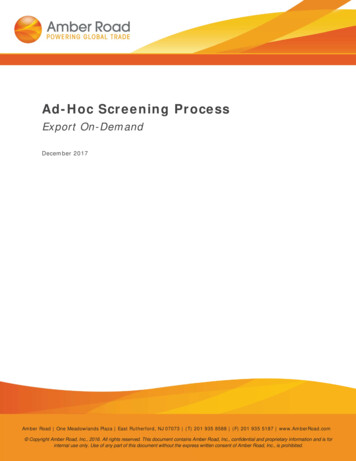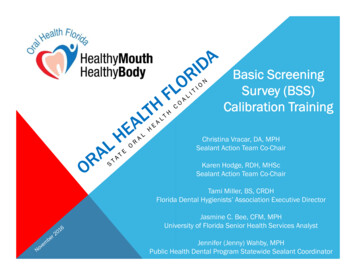
Transcription
Basic ScreeningSurvey (BSS)Calibration TrainingChristina Vracar, DA, MPHSealant Action Team Co-ChairKaren Hodge, RDH, MHScSealant Action Team Co-ChairTami Miller, BS, CRDHFlorida Dental Hygienists’ Association Executive DirectorJasmine C. Bee, CFM, MPHUniversity of Florida Senior Health Services AnalystJennifer (Jenny) Wahby, MPHPublic Health Dental Program Statewide Sealant Coordinator
What is the BSS? The Basic Screening Survey is a standardized methoddeveloped and maintained by the Association of Stateand Territorial Dental Directors (ASTDD) to collect oralheath indicators. It provides a framework for obtainingoral health data that is inexpensive and easy toimplement, yet always consistent. Data can then be compared across programs,agencies, and states.
What is the BSS? The BSS has two parts:1. Direct observation of a child’s mouth,screening (not an exam)2. Questions asked of, or about, the child beingscreened ASTDD’s BSS Children’s Manual was last updatedin June 2015. This revision removed the EarlyChildhood Caries indicator from the BSSmethodology.
Who should use the BSS? All Florida School-Based Sealant Programs (S-BSPs) shoulduse the BSS and record indicators in a standardized way (i.e.SEALS). Sealant Action Team SEALS 9.27OHFSEALSTraining.wmv This will allow for data to be compared across: Programs Florida’s state-level surveillance projects National estimates
Who does use the BSS? All of Florida’s statewide active oral healthsurveillance activities follow the BSSmethodology. www.flhealth.gov/dental/reportsAll states submitting oral health surveillance datato the National Oral Health Surveillance System(NOHSS) utilize the BSS methodology. tml
What indicators are collected? Depending on the population receiving directobservation (screenings) oral health indicatorscollected as part of the BSS are:1.2.3.4.Untreated Decay (Yes, No)Treated Decay (Yes, No)Dental Sealants on Permanent Molars (Yes, No)Treatment Urgency (None, Early, and Urgent)
Are all indicators collected forall populations? No, indicators vary for the population served Preschool Aged Children (including Early Head Start andHead Start): Untreated Decay, Treated Decay, andTreatment Urgency* School Aged Children (Kindergarten to 12th Grade):Untreated Decay, Treated Decay, Sealants on PermanentFirst and Second Molars, and Treatment Urgency*ECC was removed with the 2015 update
Diagnostic Criteria 1:Untreated Decay A measure of untreated disease. Does this child have any cavities that have not beentreated? Can include both primary & permanent teeth
Definition of Untreated Decay A tooth is considered to haveuntreated decay when thescreener can readily observebreakdown of the enamel surface. In other words, only cavitatedlesions are considered to beuntreated decay
Untreated Decay YesSmooth Surface
Untreated Decay Yes Retained roots decayThis child would be classified as havinguntreated decay.
Untreated Decay YesPits & Fissures
Untreated Decay No Teeth with stained pits & fissures and NO enamel break areconsidered soundThis tooth has stain but NOenamel break so it is SOUND.
Untreated Decay No Broken or chipped teeth are considered sound unless a cavity isalso presentNOTUntreated Decay
Untreated Decay No “White spot” lesions are not untreated decayThis tooth has “white spots” but nobreak in the enamel surface.
Rule of Thumb When in doubt, be conservative. That means that if you are not sure if a cavity ispresent, assume it is not.
Coding for Untreated Decay No untreated decay 0 (no) Untreated decay 1 (yes) Missing 99 Please note, these codes correspond with CDC’sSEALS Excel-based software application.
Coding for Untreated Decay: SEALS
Diagnostic Criteria 2:Treated Decay Does this child have any treated decay? Includes: amalgam and/or composite restorations becauseof decay temporary restorations because of decay crowns because of decay teeth missing because of decay
Be Aware of Composites!Preventive Resin Restoration or Sealant?It can be difficult to differentiate between a preventive resinrestoration (PRR) and a dental sealant. If you can see a preparationunder a sealant, code it as treated decay rather than a dentalsealant. In other words, preventive resin restorations are consideredto be the equivalent of a filling.*
AmalgamFillingsTreatedDecay YesSAME INDIVIDUALCompositeFillings
Treated Decay No Teeth extracted for orthodontics are not treated decayThis person has missing premolarsbecause of orthodontics so they do NOThave treated decay.
Treated Decay No Crowns placed because of trauma are not treateddecayThis person has a crown becauseof trauma so they do NOT havetreated decay.
Coding for Treated Decay No treated decay 0 (no) Treated decay 1 (yes) Missing 99 Please note, these codes correspond with CDC’sSEALS Excel-based software application with a minorcaveat: caries experience.
Coding for Caries Experience: SEALS What is caries experience? Caries experience is defined as the presence of either untreatedor treated (restored or filled) tooth decay. If you marked Yes (1) for Untreated Decay for Question 12, youwill also mark Yes (1) for Caries Experience for Question 13 inSEALS. If you marked No (0) for Untreated Decay for Question 12, youmay also need to mark Yes (1) for Caries Experience for Question13 in SEALS if treated decay (filling) is present.
Caries Experience* Caries experience isn’t a separate BSS indicator in and of itself. It is acombination of two BSS indicators: Untreated and Treated Decay. If you are using SEALS, Q13: Caries experience means treated or untreated decay in anyteeth, not just those charted. Calculation from SEALS data:o Caries Experience Untreated Decay Treated Decayo Treated Decay Caries Experience – Untreated Decay*For more information, refer to the SEALS Users Manual and Technical Notes
Coding for Caries Experience: SEALS
Diagnostic Criteria 3:Sealants The presence of dental sealants is an oral health indicator forchildren in elementary, middle and high school. If you are onlyscreening preschool children, do not collect this indicator. Children will be coded as having sealants if they have at leastone sealant on a permanent molar tooth, whether or not thesealant covers all or part of the pits or fissures or is partiallylost. Do not record sealants on primary teeth.
Diagnostic Criteria 3:Sealants Preventive Resin Restoration or Sealant: It can bedifficult to differentiate between a preventive resinrestoration (PRR) and a dental sealant. If you can see apreparation under a sealant, code it as treated decayrather than a dental sealant. In other words, preventiveresin restorations are considered to be the equivalent ofa filling.*
Dental Sealants Yes Permanent molars only Can lightly “feel” occlusal surface for transparent sealantsTransparent SealantOpaque Sealant
Dental Sealants Yes Include both partially and fully retained sealantsPartially RetainedSealantFully RetainedSealant
Dental Sealants No Composite fillings are not sealants:
Coding for Dental Sealants No sealants 0 (no) Sealants 1 (yes) Missing (unknown) 99 Please note, these codes correspond with CDC’sSEALS Excel-based software application.
Coding for Dental Sealants: SEALS
Diagnostic Criteria 4:Treatment Urgency Urgent Dental Care Early Dental Care No Obvious Problems
Diagnostic Criteria 4:Treatment UrgencyCategoryRecommendation for nextdental visitCriteriaUrgent need for dentalcareAs soon as possible(within 24-48 hours)Signs or symptoms thatinclude pain, infection, orswelling.Early dental care neededWithin several weeks orbefore next regularlyscheduled appointmentCaries withoutaccompanying signs orsymptoms or children withother oral health problemsrequiring care before theirnext routine dental visitNo obvious problemsNext regular checkupAny patient without belowissues/problems
Diagnostic Criteria 4:Treatment Urgency Urgent Dental Care Urgent need for dental care is used for those who needdental care within 24 to 48 hours because of signs orsymptoms that include pain, infection or swelling. Inchildren, the most common reason for being classified asneeding urgent care is an abscess.
Treatment Urgency: Urgent Urgent need Needs dental care within 24 to 48 hours because ofsigns or symptoms that include pain, infection, orswellingThis person has an abscessso they need URGENT care
Diagnostic Criteria 4:Treatment Urgency Early Dental Care If someone needs to see a dentist because of untreated decayor a broken filling, but they do not have pain or an infection,they are classified as needing early dental care. For ourpurposes, early treatment means that they should see adentist within the next several weeks or before their nextregularly scheduled dental appointment. An individual with abroken or missing filling, but no other untreated decay, wouldbe classified as needing early dental care.
Treatment Urgency: EarlyEarly dental care : Needs to see a dentist because of untreated decay orbroken restorations but they do not have pain or an infection Should see a dentist within the next several weeks or before their nextregularly scheduled dental appointmentThis child needs early dental care
Diagnostic Criteria 4:Treatment Urgency No Obvious Problems Children with no untreated decay or other dentalproblems requiring regular preventive dental services orearly attention are considered to have no obviousproblem, which means that they should receive routinedental checkups. Decay only on primary teeth about to be exfoliated child can have decayed teeth but not need treatment
Treatment Urgency: NoneThis child has no obvious need fordental care
Treatment Urgency: NoneThis child has untreated decay butno obvious need for dental carebecause the decayed tooth is aboutto exfoliate.
Coding for Treatment Urgency 3 levels based on how soon a child should visit the dentistfor a clinical diagnosis and any necessary treatment No obvious problem 0 Early care needed 1 Urgent need 2 Missing 99Please note, these codes correspond with CDC’s SEALS Excel-basedsoftware application.
Coding for Treatment Urgency: SEALS
BSS Coding Examples: All Indicators Utilize the BSS Coding Example handout included with thisCitrix webinar to record your responses to each of thefollowing examples and indicators. If you have not done so already, download the BSS CodingExample handout from the Citrix control panel.
Coding Example 1Untreated Decay Treated Decay Sealants Treatment Urgency
Coding Example 1Untreated Decay 1 (decay on distalof canine)Treated Decay 0Sealants 0Treatment Urgency 1
Coding Example 2Untreated Decay Treated Decay Sealants Treatment Urgency
Coding Example 2Untreated Decay 0 (no break inthe enamel)*Dr. Zapert’s Incipient Caries eatmentIncipientCaries EZapert.pdfTreated Decay 0Sealants 0Treatment Urgency 0
Coding Example 3Untreated Decay Treated Decay Sealants Treatment Urgency
Coding Example 3Untreated Decay 1 (there is abreak in the enamel)Treated Decay 0Sealants 0Treatment Urgency 1
Coding Example 4Untreated Decay Treated Decay Treatment Urgency
Coding Example 4Untreated Decay 1Treated Decay 0Treatment Urgency 1 (no pain,swelling or infection)
Coding Example 5Untreated Decay Treated Decay Treatment Urgency
Coding Example 5Untreated Decay 1Treated Decay 0Treatment Urgency 2(abscess)
Coding Example 6Untreated Decay Treated Decay Treatment Urgency
Coding Example 6Untreated Decay 0Treated Decay 1 (compositerestorations on primary molars)Treatment Urgency 0
Coding Example 7Untreated Decay Treated Decay Treatment Urgency
Coding Example 7Untreated Decay 1Treated Decay 1 (molars aremissing because of decay)Treatment Urgency 1
Coding Example 8History: Child fractured tooth in agymnastics accident. She is in nopain and has no infection.Untreated Decay Treated Decay Treatment Urgency
Coding Example 8History: Child fractured tooth in agymnastics accident. She is in nopain and has no infection.Untreated Decay 0 (the tooth isfractured not decayed)Treated Decay 0Treatment Urgency 1 (no pain orinfection)
Coding Example 9Untreated Decay Treated Decay Sealants Treatment Urgency
Coding Example 9Untreated Decay 0Treated Decay 0Sealants 1 (partially retainedsealant on 1st molar)Treatment Urgency 0
Coding Example 10Untreated Decay Treated Decay Sealants Treatment Urgency
Coding Example 10Untreated Decay 1 (break inenamel on primary molar)Treated Decay 0Sealants 0Treatment Urgency 0 (decayedtooth about to exfoliate)
Coding Example 11Untreated Decay Treated Decay Sealants Treatment Urgency
Coding Example 11Untreated Decay 0Treated Decay 1Sealants 0Treatment Urgency 1 (brokenfilling)
Coding Example 12Untreated Decay Treated Decay Sealants Treatment Urgency
Coding Example 12Severe FluorosisUntreated Decay 0Treated Decay 0Sealants 0Treatment Urgency 0*Severe fluorosis is not from Community Water Fluoridation
Coding Example 13Untreated Decay Treated Decay Sealants Treatment Urgency
Coding Example 13Untreated Decay 0 (primarymolar has enamel hypoplasia)Treated Decay 0Sealants 1Treatment Urgency 0
Logistic Questions What lighting is required? The BSS assumes that natural and/or overhead lighting will beavailable but requires an additional light source that can be focusedon the teeth. Lighting options include: Flashlight/Penlight, portabledental light, non-dental exam light, or head lamp. Can screeners use loupes? BSS screeners should not use loupes unless the screener’s eyesightis such that they cannot see the tooth without loupes. How can I get a ‘good look’ in the mouth? Tongue blades or disposable mirrors can be used.
Logistic Questions Continued How do I find cavities or sealants when teeth are covered by food? If tooth surfaces cannot be visualized because debris obscures the view, a toothbrushis most effective for cleaning away the food. Alternatively, a toothpick or the woodenend of a cotton-tipped applicator may be used to dislodge debris. For teeth that aretoo wet to see the tooth surfaces, screeners can use a cotton-tipped applicator, cottonroll or gauze square to soak up saliva. Do I need to use a dental explorer for the screening? No, dental explorers are not standard equipment for this screening model and theiruse for determining the presence of caries, especially newly erupted teeth with pitsand fissures is discouraged. If you use explorers, they should NEVER be used todetermine a “stick” or “tugback” in a suspected carious lesion. S-BSPs should NEVER use an explorer to determine untreatedcaries.
Logistic Questions Continued Do I need to wear gloves? In general, the basic screening survey procedures assumethat you will not touch the child directly with your handsduring the screening. Based on this assumption, the useof examination gloves may not be necessary; howeverASTDD does recommend that all screeners wear gloves inthe event you inadvertently come in contact with saliva ororal soft tissues. Florida S-BSPs are encouraged to always wear latexfree gloves.
Additional Information Additional information and expanded explanations canbe located in ASTDD’s BSS Manual: http://www.astdd.org/basic-screening-survey-tool/
Acknowledgements Association of State and Territorial Dental Directors fordeveloping the BSS methodology, manual, andtraining materials. Drs. John Warren, Amid Ismail and Eugenio Beltranfor providing the clinical photos. Florida Department of Health Public Health DentalProgram for providing the Citrix webinar and support.
Contact InformationOral Health Florida Sealant Action Team: actionteam/Sealant Action Team Co-Chairs: Christina Vracar, DA, MPH Christina.Vracar@flhealth.gov or 850-245-4476 Karen Hodge, RDH, MHSc Karen.Hodge@flhealth.gov or 727-588-4040 x3135
Contact InformationFlorida Dental Hygienists’ Association Executive Director Tami Miller, BS, CRDH Tami@fdha.org or 860-896-0603University of Florida Senior Health Services Analyst Jasmine C. Bee, CFM, MPH JCalhoun@dental.ufl.edu or 850-245-4444 x2824Florida Department of Health Public Health Dental ProgramStatewide Sealant Coordinator Jennifer (Jenny) Wahby, MPH Jennifer.Wahby@flhealth.gov or 850-245-4444 x2821
dental visit Criteria Urgent need for dental care As soon as possible (within 24-48 hours) Signs or symptoms that include pain, infection, or swelling. Early dental care needed Within several weeks or before next regularly scheduled appointment Caries without accompanying signs or symptoms or children with other oral health problems
